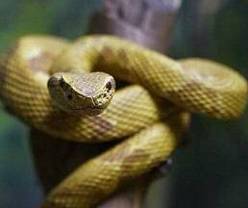Facts about the different types of snakes |

Custom Search
|
|
When we think of limbless, elongated and flexible reptiles, almost immediately snakes come to mind, and most humans when thinking of snakes quickly distinguish 2 major types of snakes:
- Venomous snakes, capable of producing and injecting snake venom through specialized teeth called fangs. - Non-venomous snakes, that lack the venom but make for it with sheer muscular power that they use to subdue and kill their prey. There are around 2900 species of snakes and from those nearly 700 are considered venomous. Most snake species are considered harmless to humans and most venomous species don’t even produce venom that’s toxic enough to kill a person. For the non-venomous snakes it’s all about size and power. A small constrictor like the black racer snake isn't capable of killing a human, that’s why Hollywood snake movies will feature giant green anacondas or pythons.
Snakes like all animal species are classified using taxonomy, and belong to the suborder Serpentes, which is furthermore divided into several families. Read on to understand a few basic facts about the different families of snakes:
Elapidae – Elapid snakes These snakes are mostly found in the tropical and subtropical regions of the world including the Indian Ocean and the Pacific. These are some the most venomous snakes in the world. They have a very characteristic feature which is their fixed, hollow fangs, which they use to inject venom into the prey. Their potent venom is mainly neurotoxic, and causes severe damage to nervous system, and can be potentially deadly in many species of Elapid snakes. The sea snakes, are also considered elapids by some taxonomists although others consider it as a different family of venomous snakes altogether, the Hydrophiidae. The sea snakes evolved and adapted to their marine life in different ways. Their tails are flattened so they can use it for swimming, and can also excrete salt. Some of the better known snakes in the Elapidae family include the Black Mamba, Indian Cobra, King Cobra, Cape Cobra, Green Mamba and sea snakes like the Belcher's Sea Snake or Olive Sea Snake. Viperidae – Viperid snakes Viperidae or the vipers are other important family of venomous snakes, found in the Americas, Africa and Eurasia. They are also the only venomous snakes found in the UK. The snake species in this family are best known for their characteristic long, hinged hollow fangs, the opposite of the elapids which have fixed fangs. The viper’s fangs can retract and extend, when not in use the fangs stay folded back against the top of the snake's mouth. When the snake opens its mouth for a bite, the fangs extend and get into the biting position. There is a sub-family called pit vipers because of their heat sensing pits located on the sides of their head. Commonly known viper snake species include the Russell's Viper, Saw-scaled Viper, Gaboon Viper and the western diamondback rattlesnake. Colubridae - Colubrid snakes
The colubrid snakes belong to the Colubridae family and are known as the largest snake family. But for the most part these are non-venomous snakes or they produce lightly toxic venom, too weak to cause any harm to humans. However, there are some deadly exceptions, like the boomslang or the twig snake, whose bites are known to have caused human fatalities. The colubrid snakes have their fangs located not at the front but in the back of their mouth, this is why they are also referred as rear-fanged snakes. Unlike the elapids or the vipers, their fangs are not hollow, but simply grooved to channel the venom when a bite is delivered. Some common examples of colubrid snakes include the california kingsnake, boomslang, Corn Snake and the Black Rat Snake. Boidae - Boa snakes This snake family comprises only non-venomous, but there are some big and powerful constrictor snakes. Among them are some of the biggest snakes in the world capable of swallowing a fully-grown buck or other large animals like the capybara! These snakes rely entirely on their strength to suffocate and kill their prey, unlike the venomous species that use venom as their primary weapon. They don't have fangs to inject venom but rows of sharp teeth in their upper and lower jaws. It's very interesting the way these large reptiles kill their preys. When the snake coils around a prey, it seems to further tighten their grip every time the prey breathes out. Scientists think the snakes can sense the prey's heartbeat, and when it stops the stop squeezing and start eating the prey whole. They can found in America, Africa, Europe, Asia, and some Pacific Islands. Some of the more popular species are the emerald tree boa, green anaconda, boa constrictor or the US native rubber boa. Pythonidae - Python snakes Just like the Boidae family, the Pythonidae family also comprises large non-venomous snakes, which kill their prey by constriction. To most people it's very easy to be confused between pythons and boas. While some of them have a very similar look and have almost the same feeding habits, on a closer look there are a number of characteristic features that set them apart. The pythons are oviparous which means they lay eggs, while most boa species give birth to live young, they are ovoviviparous. Furthermore their geographical distribution is different, pythons habitats are less extensive than that of boas. Some common examples python snakes include the african rock python, reticulated python, green tree python or the burmese python. Click the link to check out the list of snakes by name present in this site.
|
Did You Know?
The australian inland taipan bite contains venom enough to kill up to 100 full grown men. |
© 2014 Snake Facts About Us | Privacy Policy | Contact






